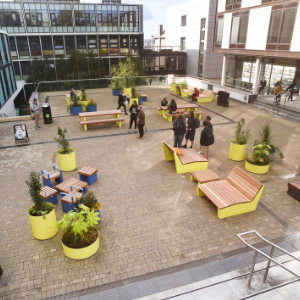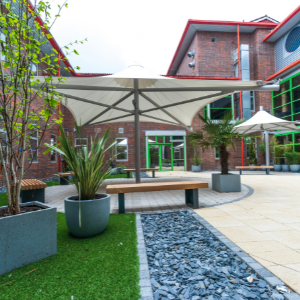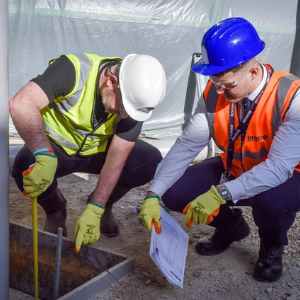As cities grow denser and technology continues to dominate our lives, finding ways to reconnect with nature becomes crucial. One approach gaining popularity in urban planning and landscape architecture is biophilic design, which adds natural features into the built environment.
This design philosophy can transform public, commercial, corporate and private spaces into areas of natural beauty and well-being.
What is biophilic design?
Biophilic design is an innovative concept that deepens the connection between nature and built environments. Originating from the term ‘biophilia’, which means love of nature, biophilic design acknowledges our innate connection to the natural worlds.
It aims to create spaces that enhance our physical and mental well-being by incorporating elements such as natural light, water features and organic materials. In outdoor spaces, this can mean anything from parks filled with diverse plant life to urban areas that feature water streams and natural rock formations.
What are the benefits of biophilic design?
The health benefits of biophilic design are vast and well-documented. An evidence-based review on biophilic-designed environments published in JPPE (Journal of People, Plants and Environment) states that “the presence of natural images, natural material, and plants in outdoor or interior environments can reduce psychological and physical stress, recover attention restoration, and improve positive emotion and aesthetic attraction, thereby benefiting human health.” Their findings can be linked to the three of the seventeen Sustainable Development Goals set out by the United Nations.
Biophilic design has also been shown to have significant positive impacts on mental health by reducing stress and enhancing mood. This means that incorporating biophilic principles can create environments where people feel more relaxed and content. Physically, access to nature encourages outdoor activities, which can lead to better overall health. Biophilic design can also enhance social interactions by providing inviting communal areas where people naturally want to gather.
Beyond individual well-being, biophilic spaces can also improve environmental health by supporting biodiversity through strategic planting and green infrastructure.
How can I incorporate biophilic design into my outdoor space?
Incorporating biophilic design into your outdoor space doesn’t require a complete overhaul. Consider integrating natural forms such as water streams and rock formations to create a more organic and inviting space. Using natural patterns in the layout and design can enhance the aesthetic appeal and create a more harmonious environment.
You can start with small changes and gradually build upon them, depending on the location.
Integrate natural elements
Start by adding plants and trees to the area, considering the natural shapes found in the area. This can be done using planters, seated planters, or even parklets. Consider a variety of plants to ensure year-round greenery and blooms, such as lavender and geraniums.
You may even want to place the plants near water features like fountains or small ponds to introduce soothing natural sounds and create a focal point for the space.
Use organic materials
When planning seating spaces, opt for natural materials such as wood or stone. These materials blend seamlessly with natural surroundings and evoke life and lifelike processes, enhancing the biophilic experience and creating a warm and inviting atmosphere.
Design for sensory engagement
Think about the sensory experience of your space. Incorporate plants with different textures, colours, and scents into your natural world space. Choose materials that feel good to touch and sit on, such as our selection of Timber benches and seats. The durability of our street furniture means it can be used all year round, so you can sit and relax to the sound of rustling leaves in the autumn and chirping birds in the spring.
Create natural shelter
Design areas that provide shade from the elements, such as shelters with climbing plants or green roofs to support natural systems, promoting biodiversity and ecological balance.
Green roofs serve as mini ecosystems, supporting biodiversity by attracting birds, butterflies, and other wildlife. They offer a refreshing green respite and contribute to mental well-being by creating shaded, comfortable areas that invite people socialise and engage with their surroundings, or even park their bikes in!
Our Blox shelters make the perfect base for green roofs, creating new healthy habitats as well as contributing towards improved air quality, a reduction in urban heat and rainwater management.
These spaces not only offer comfort but also encourage people to spend more time outdoors regardless of the weather.
Encourage wildlife
Creating habitats that attract birds, butterflies, and other wildlife can transform your space into vibrant natural landscapes. Birdhouses and butterfly gardens can help support local ecosystems and add life and movement to your space.
Flower baskets are the perfect way to encourage wildlife in a subtle yet successful manner. Lining up a few flower basket across your space and filling them with sunflowers, cosmos and verbenas will bring bees and butterflies to your space in no time.
Biophilic design with Broxap Street Furniture
By adding in natural and green elements, you can transform any outdoor area into a biophilic space that supports the environment and improves mental wellbeing. Incorporating natural lighting can further enhance the biophilic experience by creating a more inviting and healthful environment.
Whether it’s a small park, a large public square, a community garden, or corporate offices, biophilic design principles can help create spaces that everyone can enjoy and benefit from. Embracing our connection to nature through thoughtful design is a step toward healthier, happier, and more sustainable public spaces. Contact our friendly sales team on 01782 564411 to begin transforming your outdoor space today!


























